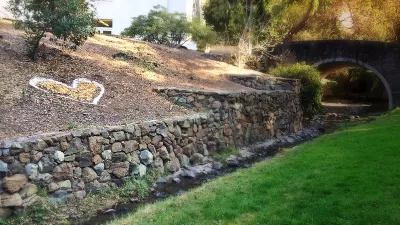Writing for National Geographic, Brian Clark Howard examines the "[innovative] techniques that mimic nature help restore open waterways, prevent pollution, and create habitats for animals."
Clark begins the article by examining the case of Broad Branch, a stream in Washington Creek, buried over a century ago in the name of malaria abatement. As problems, like pollution dumping into the Chesapeake Bay, have emerged as a result, " many cities have been undoing the past century's drainage projects, uncovering or 'daylighting' buried streams."
The article includes a guided tour provided by Keith Underwood, an Annapolis-based landscape architect hired by Washington D.C. to restore the Rock Creek drainage (of which Board Branch is a tributary). Underwood describes his work as "regenerative design," or a process of mimicking natural systems in a blend of art and engineering.
FULL STORY: In New Drainage Projects, Long-Buried Urban Streams See the Light Again

Study: Maui’s Plan to Convert Vacation Rentals to Long-Term Housing Could Cause Nearly $1 Billion Economic Loss
The plan would reduce visitor accommodation by 25,% resulting in 1,900 jobs lost.

North Texas Transit Leaders Tout Benefits of TOD for Growing Region
At a summit focused on transit-oriented development, policymakers discussed how North Texas’ expanded light rail system can serve as a tool for economic growth.

Why Should We Subsidize Public Transportation?
Many public transit agencies face financial stress due to rising costs, declining fare revenue, and declining subsidies. Transit advocates must provide a strong business case for increasing public transit funding.

How to Make US Trains Faster
Changes to boarding platforms and a switch to electric trains could improve U.S. passenger rail service without the added cost of high-speed rail.

Columbia’s Revitalized ‘Loop’ Is a Hub for Local Entrepreneurs
A focus on small businesses is helping a commercial corridor in Columbia, Missouri thrive.

Invasive Insect Threatens Minnesota’s Ash Forests
The Emerald Ash Borer is a rapidly spreading invasive pest threatening Minnesota’s ash trees, and homeowners are encouraged to plant diverse replacement species, avoid moving ash firewood, and monitor for signs of infestation.
Urban Design for Planners 1: Software Tools
This six-course series explores essential urban design concepts using open source software and equips planners with the tools they need to participate fully in the urban design process.
Planning for Universal Design
Learn the tools for implementing Universal Design in planning regulations.
City of Santa Clarita
Ascent Environmental
Institute for Housing and Urban Development Studies (IHS)
City of Grandview
Harvard GSD Executive Education
Toledo-Lucas County Plan Commissions
Salt Lake City
NYU Wagner Graduate School of Public Service




























